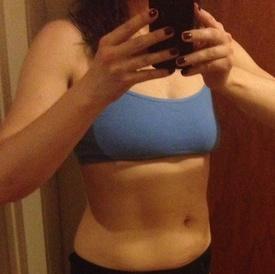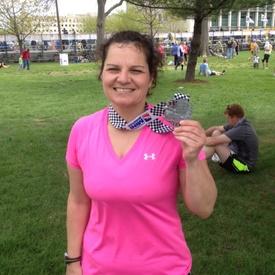Tips & Tricks
Replies
-
I just started running, so I didn't have any real running shoes or clothes. I'd been working out with cotton socks, old shoes, and regular yoga pants/shirts. I realized, after buying some new shoes, socks, and workout clothes that it's a night and day difference! I wasn't overheated today running, I could run for the full amount of time without feeling like I was hyperventilating! It doesn't have to be expensive, just the appropriate material, etc!0
-
Get out in the elements. Believe it or not, breaking free from your comfort zone in more than just one way does amazing things to the mind!1
-
Take time to stretch AFTER every run. If you can stretch for 30 seconds for each stretch, even better!
The stretching will keep you limber and help you to not get injured.1 -
Hello All.. I have just started my C25K program. How do you guys do strength training?
Suppose you run on MWF, do you lift weights/cross train on Tuesdays and Thursdays? Pls share your ideas.
Thanks in advance!0 -
 0
0 -
Hi, W1D1 was yesterday. We shall see how this goes.0
-
bump0
-
Hi, this post is fab, tonight plan wk 3 Day 2, I have booked myself to do a 5k race for life on 23rd June 2013, hopefully i'll be well into the programme at this point.
I'm going to create a playlist to listen to whilst doing the workout with loads of motivating upbeat music.0 -
Hello all,
Found this on my running club's website and wanted to share it.
THE PHYSIOLOGY OF TRAINING
Pacing can be confusing. Sometimes it's difficult to determine if you are going too fast or too slow. Be sure to wear a Garmin if you have one. Look at the pacing times for your group and practice – go out and see what kind of walk/run combination it might take to stay at that pace.
Our coaching goals are to help our women develop or improve an exercise program of walking, walk/running or running, to be safe, have fun, have less injury, and to finish the “Graduation” 5K stronger and healthier than when they started. Injury can prevent this. It’s important to for our participants to take it easy and give their bodies time to adapt.
BASE
It is important to slowly build a consistent base of weekly mileage at a slower pace. The BASE increases VO2Max, increases endurance, and improves recovery. Weekly mileage should not increase more than 10% over the previous week’s mileage. Every third week do not increase mileage. Endurance is built on this base; speed work and hill work is done much later to sharpen your skills. It is as important to have a consistent number of days running as it is the mileage. For instance, if you run 2-3-2-3-6 (total mileage 16 miles) do not try to substitute two 8 mile days one week.
~ The first improvement in fitness is Aerobic – lung capacity and blood volume
It is important to maintain hydration during this period as the blood volume increases. It is possible to experience short term ‘runner’s anemia’ as the plasma increases faster than red blood cells.
~ The second improvement in fitness is the Muscular System
The muscles build ATP glycogen & fat (the fueling system) and increasing amounts of muscle mass and Mitochondria at the cellular level (this development is most efficient when muscles are worked at an aerobic – slow – pace). Aerobic, slow easy paces allow this to happen.
~ The last to adapt are Tendons, Bones & Ligaments. It can take as much as 2-6 months for these to strengthen and adapt. This is what will break down and where the injuries will be.
Thus the beginning runner starts to feel good – Aerobic capacity has increased, muscles are stronger so they push the mileage and/or speed, if they feel some little twitches and twinges they ignore them and BOOM – injury.
What does this mean in regard to training WRWM participants?
* You need to be trained where you are now. Not what you did in high school, or five years ago, or pre-pregnancy, and not what you wish you could do without any concrete reasons to believe it’s possible.
HEAT ADAPTATION
It takes a minimum of TEN runs in heat to acclimate. The circulatory system adapts in several ways, doubling the number of sweat glands, sweating will start at a lower temperature, and reducing the number of electrolytes lost in sweat.
What does this mean in regard to training WRWM participants?
* If you have not been out in the heat, walking, jogging, etc., you will need at least TEN workouts during this training time to adapt to the heat. For intermediate and advanced runners this will probably not be an issue. For beginning runners, try to get outdoors even just for a slow walk around the block.
DE-TRAINING
After three days you begin to de-train. Do something that third day, even if you just run one mile, in order to keep the body used to the activity.
Be consistent in your training even if we have to cancel due to heat: do your run early in the morning or later in the evening, or inside if you have access to treadmill or a fitness facility1 -
Keeping my pace slow and consistant and keeping my breath under control0
-
The thing I don't hear talked about much is "RUNNING FORM". In the past 3 months I've almost totally changed from a slouched heel strike to a fw leaned midfoot. The result have been amazing in regards to aches & pains.
But I'm still working through leg extension. I've heard 2 theories:
1-full extension behind you
2-short compact stride under you
Which works best for you?1 -
Thanks for all of the advice, I just started C25K (W1D1). I am really excited about it.0
-
Found this on Woman's Running Magazine's website....
Great tips! Thank you!0 -
The thing I don't hear talked about much is "RUNNING FORM". In the past 3 months I've almost totally changed from a slouched heel strike to a fw leaned midfoot. The result have been amazing in regards to aches & pains.
But I'm still working through leg extension. I've heard 2 theories:
1-full extension behind you
2-short compact stride under you
Which works best for you?
I don't harp on form because most people seem to evolve this during the program. Also, nobody here is all that experienced.
In terms of leg extension...it's hard to explain. If you're angled forward with a good strike under you, your rear extension is almost lifting your leg from the ground rather than pushing against it. It's almost a wheel-like or cycling feeling. I usually start a run with a shorter compact stride and then open up later when everything comes together and I'm flying. I think it's whatever keeps my turnover up without over-exerting.0 -
Hello All.. I have just started my C25K program. How do you guys do strength training?
Suppose you run on MWF, do you lift weights/cross train on Tuesdays and Thursdays? Pls share your ideas.
Thanks in advance!
Yes. I do Pilates Monday, and weights Wednesday and Friday.0 -
Stick to the simple rule of: above the neck keep going, below the neck take a day off (in regards to feeling under the weather).0
-
So, I'm a new runner but not that, new either. I had been running on and off for three weeks before I started the program. This week I ran 5 out of 7 days. I use the general training guide but I use Runtastic to actually guide me through the workout since I'm used to it and I like its GPS features. This week I repeated week 1, 4 times with a 5 min cool down and warm up and instead of 8 reps I did 10 (60 sec run 90 walk). This last run, in a total of 35:30 min I ran 2.6 mi. I would like to run 5 times per week with a break Wednesdays and Sundays. Does this seem unreasonable to anyone? Will I get injured. Thanks for your help!
 0
0 -
It's best to follow the program as written. Two of the red flags for injury are being a new runner (under a year) and over training. I can't say that you'll get injured, but why risk it? You've got the rest of your life to run.1
-
Bump Bump Bumpity Bump0
-
Fantastic input over the course of almost two years!
This is a nice article:
http://beta.active.com/articles/running/when-does-running-get-easier-for-beginners0 -
-
0
-
I started at 300, and went down a few in short order. Just watch your knees, ankles, feet, etc. Remember how hard those limbs are working to keep you upright and take good care of them.0
-
Running form, I always catch myself slouching. Shoulders back face ahead, it helps keep your lungs expanded.0
-
A gym trainer once gave me some awesome advice for running, which was to run Long, Light and Low. Take long strides, but not so long that you are having to land on your heel, keep your landing light (imagine you are running on thin ice), and don't lift your legs up really high between strides, but glide along just above the ground.
My problem a couple of years ago was that I was too rigid while running, with not enough movement in my hips, and (I think) that meant that my hip flexors rather than my butt muscles were doing all the work. If you can get to a local running group or get someone who knows what they're talking about to give you some posture tips it'll set you up well for when you want to increase the distance.0 -
Hello! I am just starting out again after having my 2nd baby (week 1, day 2 done). When I did the program the first time, it worked really well, but during Week 7 I got an injury in my left leg. After a few weeks off, my physio told me strength straining was just was important, and then he gave me a simple plan of squats and lunges, that kind of thing. So squat squat squat
 0
0 -
Wow, so glad I found this group! I am just finishing week 1 of C25K. Really want to complete a 5K this year but no one wants to be my 5K buddy, looks like I will go it alone as I am determined!0
-
Fueling
Taken from Runner's World
Stay hydrated.
Hydration is a big one with running. If you aren't properly hydrated it can cause issues with your running and recovery. But you don't want to down a whole lot of water the night before or the morning of, at that point it is too late and the water won't get to your muscles to be used properly. So that week before your race make sure you are hydrating very well.
No need to carb load.
The practice of carb loading (increasing your intake of carbohydrate-heavy foods while cutting back on protein and fat in the days before a race) is geared for events of 90 minutes or longer. And even if you end up having to run/walk the 5K, you will be finished long before that 90 minute mark. A healthy prerace meal or snack will provide enough carbs to help you through your run. The only issue here really, is if you do a low carb diet. If you are one of those people, then try and hit a 40/30/30 macro adjustment a day or two before the race. That will help to make sure you have enough carbs in you to not bonk afterwards.
Eat a light prerace breakfast.
Focus on a small breakfast or snack, about 200-300 calories tops. Something with a good amount of good carbs such as oatmeal or an english muffin with jelly or peanut butter. You don't want this to be too heavy, as if it is too much it can play with your GI and cause discomfort in the race.
Don’t forget the fluids.
Be sure to wash down your prerace meal with plenty of fluids. Aim to consume 17 to 20 ounces of fluids two to three hours before the race, and another seven to 10 ounces 20 minutes before the race begins. It’s okay to have coffee, tea, or a sports drink if you regularly drink those fluids before your runs and they don’t upset your stomach. But if you have coffee or sports drinks make sure you keep it outside of the 60 minute window prior to race start, just to make sure you don't end up in the bathroom mid run.
Do not do anything new!
If you didn't drink that sports drink during C25K, then don't drink it during the race. That goes for the same with food. Don't eat something new or exotic the night before. It might affect your race the next day. Same thing with eating. If you are used to not eat before your runs, then do the same thing race day and opt for the snack after your race.0 -
Hellooo, I'm on Week 4, Day 3 after a bunch of repeats of Week 3, and my tips are:
-TRY the next week...I think it was all in my head that I couldn't do it. The 3 minute runs seemed really hard until they became the 'easy runs' for week 4. I did 5 min runs with no problem!! It was a mental block!
-Have a great playlist...I have two different ones on spotify for the slower pace and faster pace I run, depending on how i feel that day
-Hard to explain, but when running and my feet land on the ground, I let the pressure absorb into my hamstring rather than my foot/ankle, whatnot. It doesn't make me lose endurance as much.1 -
Get properly fitted for shoes. I did the first 4 weeks in old runners and the day after my knees would be killing me. Turns out I was overpronating, putting stress on my knees. Shoes corrected it.0
This discussion has been closed.




















